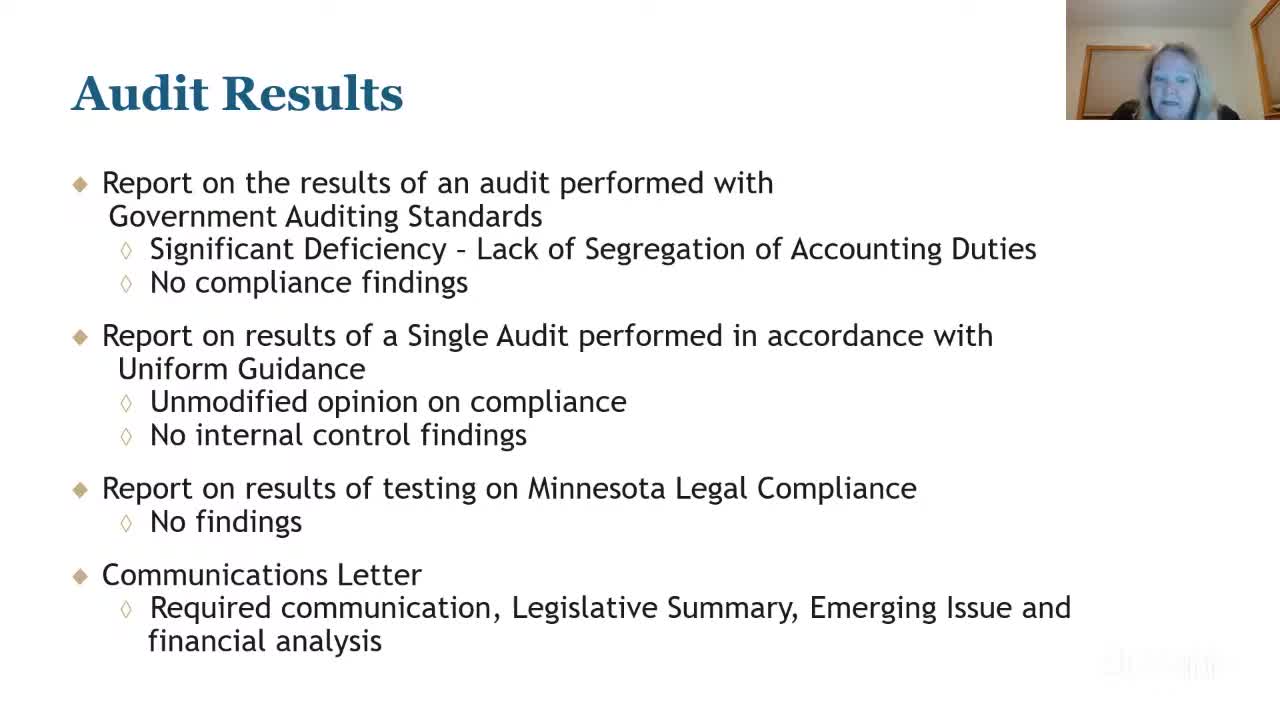Winona School District audit reveals compliance and slight student enrollment increase
December 06, 2024 | WINONA AREA PUBLIC SCHOOL DISTRICT, School Boards, Minnesota
This article was created by AI summarizing key points discussed. AI makes mistakes, so for full details and context, please refer to the video of the full meeting. Please report any errors so we can fix them. Report an error »

The Winona Area Public School District held a board meeting on December 5, 2024, where key financial updates and compliance reports were discussed. The meeting began with a presentation from the district's auditors, who provided an overview of the recent audit findings. The auditors reported an unmodified opinion on compliance regarding the child nutrition program, indicating no internal control issues were found. Additionally, the Minnesota legal compliance report revealed no noncompliance with state statutes related to accounting matters.
The auditors highlighted a single written finding related to a lack of segregation of accounting duties but noted that there were no significant issues or disagreements with management during the audit process. They also provided a financial analysis, emphasizing the district's largest funding source, general education aid, which saw a 4% increase for the 2024 fiscal year, the highest in a decade. However, projections for 2025 indicate a return to a 2% increase.
Student enrollment figures were discussed, revealing a slight increase in resident students for 2024, although the district experienced a net loss of students due to open enrollment, resulting in a total decrease of about 15 students overall. The financial report indicated that total revenues for the general fund increased by approximately 3.4%, while expenditures rose by about 4%, primarily due to special education costs associated with high-needs students.
The board also reviewed the budget-to-actual performance, noting a decrease in the fund balance of about $1.5 million, which was slightly better than anticipated. The district's total fund balance stood at approximately $4.6 million, with a significant portion restricted for state-mandated reserves. The unassigned fund balance, however, was reported at its lowest point in five years, raising concerns as it fell below the district's policy minimum of 8-10%.
The meeting concluded with an invitation for questions and comments from board members, indicating a collaborative approach to addressing the district's financial health and planning for future fiscal strategies. The board's next steps will likely involve discussions on how to improve the fund balance and address the challenges posed by declining enrollment and rising expenditures.
The auditors highlighted a single written finding related to a lack of segregation of accounting duties but noted that there were no significant issues or disagreements with management during the audit process. They also provided a financial analysis, emphasizing the district's largest funding source, general education aid, which saw a 4% increase for the 2024 fiscal year, the highest in a decade. However, projections for 2025 indicate a return to a 2% increase.
Student enrollment figures were discussed, revealing a slight increase in resident students for 2024, although the district experienced a net loss of students due to open enrollment, resulting in a total decrease of about 15 students overall. The financial report indicated that total revenues for the general fund increased by approximately 3.4%, while expenditures rose by about 4%, primarily due to special education costs associated with high-needs students.
The board also reviewed the budget-to-actual performance, noting a decrease in the fund balance of about $1.5 million, which was slightly better than anticipated. The district's total fund balance stood at approximately $4.6 million, with a significant portion restricted for state-mandated reserves. The unassigned fund balance, however, was reported at its lowest point in five years, raising concerns as it fell below the district's policy minimum of 8-10%.
The meeting concluded with an invitation for questions and comments from board members, indicating a collaborative approach to addressing the district's financial health and planning for future fiscal strategies. The board's next steps will likely involve discussions on how to improve the fund balance and address the challenges posed by declining enrollment and rising expenditures.
View full meeting
This article is based on a recent meeting—watch the full video and explore the complete transcript for deeper insights into the discussion.
View full meeting
